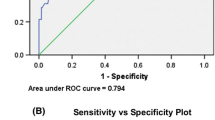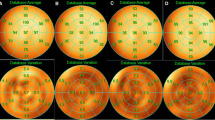Abstract
Background
Stress-only Tc-99m MPI saves time, radiation exposure, and a normal study has a benign prognosis. However, a stress-first protocol is relatively labor intensive requiring pre-test screening for suitability and early post-stress image review to determine the need for rest imaging. The purpose of this study was to develop a simple clinical score used prior to a patient’s myocardial perfusion imaging (MPI) study to determine if they should undergo a stress-first protocol.
Methods
We reviewed all patients who underwent Tc-99m SPECT MPI over a 27-month period and divided them into derivation and validation cohorts. Patients were categorized as having a successful stress-first protocol based on a summed stress score ≤1, with or without attenuation correction. We generated a multivariable model from the derivation cohort to identify demographic and clinical correlates of successful stress-first imaging. Two validation cohorts using a CZT and a conventional SPECT camera were then used to test the performance of the model.
Results
The derivation cohort included 1,996 patients and the validation cohort consisted of 1,005 CZT SPECT patients and 2,430 conventional SPECT patients. The following variables were associated with unsuccessful (i.e., abnormal) stress-first imaging: age >65 years (1 point), diabetes (2 points), typical chest pain (2 points), congestive heart failure (3 points), abnormal ECG (4 points), male gender (4 points), and documented CAD (5 points). Emergency Department location (−2 points) was negatively associated with an unsuccessful protocol. An increasing score showed a strong association with an unsuccessful stress-first protocol in both the derivation and the validation cohorts (P < .0001) and dividing the cohorts into low (<5), intermediate (≥5 and <10), and high (≥10) risk scores accurately stratified patients based on their frequencies of unsuccessful stress-first imaging. ROC curve analysis showed excellent prediction in both the derivation and the validation cohorts with an area under the curve of 0.82 and 0.75-0.83, respectively.
Conclusions
This pre-test scoring tool accurately identifies patients who can successfully undergo a stress-first imaging protocol without the need for rest imaging and may allow for wider adoption of stress-first imaging protocols.









Similar content being viewed by others
References
Berman DS, Kang X, Slomka PJ, Gerlach J, de Yang L, Hayes SW, et al. Underestimation of extent of ischemia by gated SPECT myocardial perfusion imaging in patients with left main coronary artery disease. J Nucl Cardiol 2007;14:521-8.
Shaw LJ, Hendel RC, Heller GV, Borges-Neto S, Cerqueira M, Berman DS. Prognostic estimation of coronary artery disease risk with resting perfusion abnormalities and stress ischemia on myocardial perfusion SPECT. J Nucl Cardiol 2008;15:762-73.
Gibbons RJ, Hodge DO, Berman DS, Akinboboye OO, Heo J, Hachamovitch R, et al. Long-term outcome of patients with intermediate-risk exercise electrocardiograms who do not have myocardial perfusion defects on radionuclide imaging. Circulation 1999;100:2140-5.
Shaw LJ, Hendel R, Borges-Neto S, Lauer MS, Alazraki N, Burnette J, et al. Prognostic value of normal exercise and adenosine (99m)Tc-tetrofosmin SPECT imaging: Results from the multicenter registry of 4,728 patients. J Nucl Med 2003;44:134-9.
Chang SM, Nabi F, Xu J, Raza U, Mahmarian JJ. Normal stress-only versus standard stress/rest myocardial perfusion imaging: Similar patient mortality with reduced radiation exposure. J Am Coll Cardiol 2010;55:221-30.
Duvall WL, Wijetunga MN, Klein TM, Razzouk L, Godbold J, Croft LB, et al. The prognosis of a normal stress-only Tc-99m myocardial perfusion imaging study. J Nucl Cardiol 2010;17:370-7.
Gibson PB, Demus D, Noto R, Hudson W, Johnson LL. Low event rate for stress-only perfusion imaging in patients evaluated for chest pain. J Am Coll Cardiol 2002;39:999-1004.
Heller GV, Bateman TM, Johnson LL, Cullom SJ, Case JA, Galt JR, et al. Clinical value of attenuation correction in stress-only Tc-99m sestamibi SPECT imaging. J Nucl Cardiol 2004;11:273-81.
Henzlova MJ, Cerqueira MD, Hansen CL, Taillefer R, Yao SS. ASNC Imaging Guidelines for Nuclear Cardiology Procedures: Stress protocols and tracers. J Nucl Cardiol 2009;16:331.
Depuey EG, Mahmarian JJ, Miller TD, Einstein AJ, Hansen CL, Holly TA, et al. Patient-centered imaging. J Nucl Cardiol 2012;19:185-215.
Des Prez RD, Dahlberg ST, Einstein AJ, Grossman GB, Henzlova MJ, Mahenthiran J, et al. ASNC Clinical Update: Stress-only myocardial perfusion imaging, 2009. http://www.asnc.org/imageuploads/ClinicalUpdateStressOnlyMPI2009.pdf.
Hendel RC, Berman DS, Di Carli MF, Heidenreich PA, Henkin RE, Pellikka PA, et al. ACCF/ASNC/ACR/AHA/ASE/SCCT/SCMR/SNM 2009 appropriate use criteria for cardiac radionuclide imaging: a report of the American College of Cardiology Foundation Appropriate Use Criteria Task Force, the American Society of Nuclear Cardiology, the American College of Radiology, the American Heart Association, the American Society of Echocardiography, the Society of Cardiovascular Computed Tomography, the Society for Cardiovascular Magnetic Resonance, and the Society of Nuclear Medicine. Circulation 2009;119:e561-87.
Cerqueira MD, Weissman NJ, Dilsizian V, Jacobs AK, Kaul S, Laskey WK, et al. Standardized myocardial segmentation and nomenclature for tomographic imaging of the heart: A statement for healthcare professionals from the Cardiac Imaging Committee of the Council on Clinical Cardiology of the American Heart Association. J Nucl Cardiol 2002;9:240-5.
Sullivan LM, Massaro JM, D’Agostino RB Sr. Presentation of multivariate data for clinical use: The Framingham Study risk score functions. Stat Med 2004;23:1631-60.
Hansen CL, Goldstein RA, Berman DS, Churchwell KB, Cooke CD, Corbett JR, et al. Myocardial perfusion and function single photon emission computed tomography. J Nucl Cardiol 2006;13:e97-120.
Holly TA, Abbott BG, Al-Mallah M, Calnon DA, Cohen MC, DiFilippo FP, et al. Single photon-emission computed tomography. J Nucl Cardiol 2010;17:941-73.
Navare SM, Katten D, Johnson LL, Mather JF, Fowler MS, Ahlberg AW, et al. Risk stratification with electrocardiographic-gated dobutamine stress technetium-99m sestamibi single-photon emission tomographic imaging: Value of heart rate response and assessment of left ventricular function. J Am Coll Cardiol 2006;47:781-8.
Duvall WL, Slomka PJ, Gerlach J, Sweeny JM, Croft LB, Guma KA, et al. Automated quantification of high-efficiency CZT SPECT MPI compared to clinical interpretation. J Nucl Cardiol 2012 (abstract).
Author information
Authors and Affiliations
Corresponding author
Additional information
See related editorial, doi:10.1007/s12350-012-9623-9.
Rights and permissions
About this article
Cite this article
Duvall, W.L., Baber, U., Levine, E.J. et al. A model for the prediction of a successful stress-first Tc-99m SPECT MPI. J. Nucl. Cardiol. 19, 1124–1134 (2012). https://doi.org/10.1007/s12350-012-9606-x
Received:
Accepted:
Published:
Issue Date:
DOI: https://doi.org/10.1007/s12350-012-9606-x




